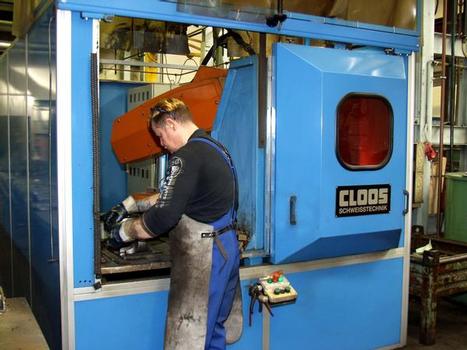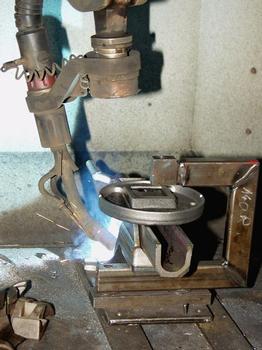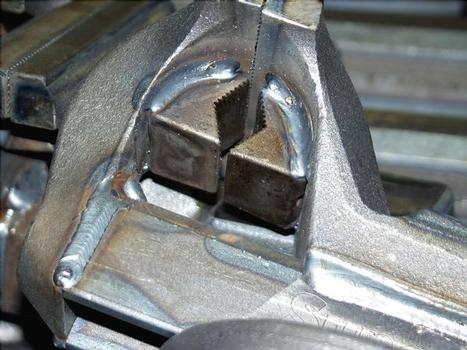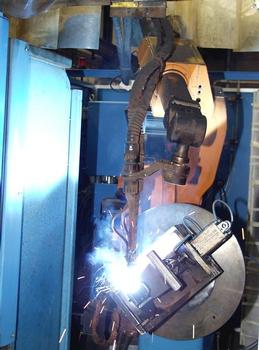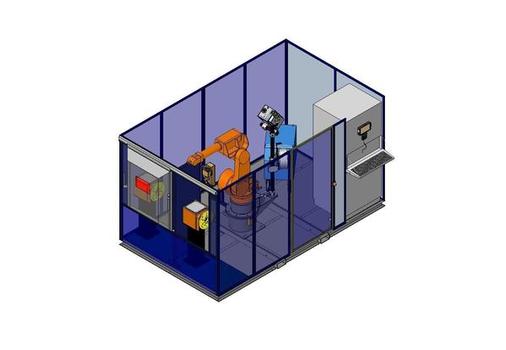Robot welding cells optimize production times
Competition is exerting enormous pricing pressure on workshop fitters. So in order to rationalize its production and maintain constant quality, RIDGE TOOL has invested in two CLOOS robot welding cells, which are optimally integrated into the production process.
Media
As in many branches of industry, even workshop fitters are suffering under colossal pricing pressures due to competition factors. In order to achieve constant quality with the corresponding quantities, the well-known tooling supplier RIDGE TOOL, a mid-size enterprise based in Gevelsberg in the heart of Germany's industrial Ruhr district, has replaced its previous welding technology with two turnkey, standardized Z-series compact cells from Haiger-based manufacturer CLOOS and are today easily producing 300 vices on them every day. These cells offer a lot of advantages, with robots, power supply and welding technology working together perfectly. And if necessary the cells can be easily transported by fork-lift within the production area and are quickly set up for operation again.
Optimization doubles productivity
Works Director Herbert Lorbach justifies his international competitiveness: "The investment in flexible robot cells is important as we are working with continuous improvement processes. This is why we are twice as productive compared with other companies.” The other machines and workstations are arranged around the two welding cells in order to minimize staff movements and also to ensure a perfect materials flow from the semi-finished parts via the welded assemblies to the finished vices – locked ‘hand in hand'. "In this way we achieve an annual output of easily 60 000 vices with a constant high quality, with only 13 production employees,” says Lorbach.
Since US tooling company Ridge Tool of Elyria, Ohio, took over Gevelsberg manufacturer Peddinghaus in 1996, production has been constantly optimized in a focused, lean manufacturing strategy, with the result that the manufacturer is operating very competitively today in the world market with quality vices – four models in different designs. "The specialist trade of workshop fitters supplying industry and manual trades are our customers, where our vices are in daily use and users will spend a few Euros more for them than a handyman or do-it-yourselfer,” says Mr. Lorbach. And for the professionals he has special solutions ready, such as a vice with integral tube chuck jaws, for optimum fixing of rods and tubes, or the quick-action chuck for even more efficiency on the building site.
Tandem and single wire in harmony
In terms of welding technology, three work processes are needed to produce a vice: one unit is produced from the plate, two side bars and the so-called rear basin using the high-speed Tandem equipment; the adjustable front part is formed from guide rails and front basins. For this purpose, the CLOOS Tandem torch has two wires arranged closely, one behind the other, which are fed simultaneously and melted in two separate arcs. In order for this to function perfectly, two microprocessor-controlled pulsed arc power sources from the Quinto series are electronically synchronized; they feed two electrically insulated welding current circuits, which enable separate adjustment of the welding parameters for each arc. This guarantees precise and top quality seams.
The weld seams for fixing the tube chucks are significantly shorter. That is why the second CLOOS cell houses a robot with single wire technology. The welding times are between 25 and 35 seconds for both units. The cells have a two-station operation for smooth production: while the employee loads raw parts in one station or removes the welded part, the robot is working in the other area.
Fully equipped – quickly ready for operation
The cells are equipped with a six-axis robot, which is controlled by the CLOOS robot control ROTROL® II and operated with the handy PHG equipment with its large display and the clear touchscreen keyboard. In the Tandem cell, the CLOOS Duo-Drive system feeds the relevant quantity of wire from two drums to the torch. The various fillet welds are welded using the MAG process: the computer-controlled CLOOS Quinto pulsed arc welding machine produces a low-splash arc and high, reproducible seam quality every time. Herbert Lorbach knows: "This minimizes any reworking, and complaints are less than one per thousand.” The production cells each have one automatic welding torch cleaning station, which cleans the torches regularly.
All components, including all cables and hoses, are fitted to a common basic frame and surrounded by the protective housing. Each cell is approx. 3900 mm long, 2200 mm wide and 2000 mm high, and weighs about 2800 kg. The customer simply positions the equipment tested in the factory in his production environment, and after connection to electrics, compressed air and inert gas, can quickly start working with it. "In order for everything to function smoothly, our operators get to know the equipment during their training and the programming course at CLOOS,” explains Herbert Lorbach. "These robot cells are the backbone of our production. That is why we are also pleased with the high reliability of CLOOS technology.”
- About this
data sheet - Product-ID
6290 - Published on:
24/05/2013 - Last updated on:
30/01/2016

